Astronomy
| I |
| INTRODUCTION |
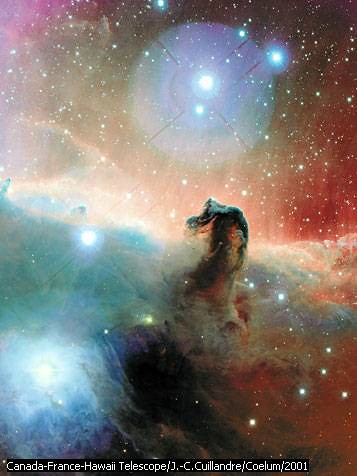
Horsehead Nebula
The Horsehead Nebula, located over 1,000 light-years away in the constellation Orion, is an enormous interstellar cloud of gas and dust. This dark nebula is visible from Earth only because it blocks light emanating from young stars located behind the nebula.
Canada-France-Hawaii Telescope/J.-C.Cuillandre/Coelum/2001
Astronomy, study of the universe and the celestial bodies, gas, and dust within it. Astronomy includes observations and theories about the solar system, the stars, the galaxies, and the general structure of space. Astronomy also includes cosmology, the study of the universe and its past and future. People who study astronomy are called astronomers, and they use a wide variety of methods to perform their research. These methods usually involve ideas of physics, so most astronomers are also astrophysicists, and the terms astronomer and astrophysicist are basically identical. Some areas of astronomy also use techniques of chemistry, geology, and biology.
Astronomy is the oldest science, dating back thousands of years to when primitive people noticed objects in the sky overhead and watched the way the objects moved. In ancient Egypt, the first appearance of certain stars each year marked the onset of the seasonal flood, an important event for agriculture. In 17th-century England, astronomy provided methods of keeping track of time that were especially useful for accurate navigation. Astronomy has a long tradition of practical results, such as our current understanding of the stars, day and night, the seasons, and the phases of the Moon. Much of today's research in astronomy does not address immediate practical problems. Instead, it involves basic research to satisfy our curiosity about the universe and the objects in it. One day such knowledge may well be of practical use to humans. See also History of Astronomy.
| II |
| AMATEUR ASTRONOMY |
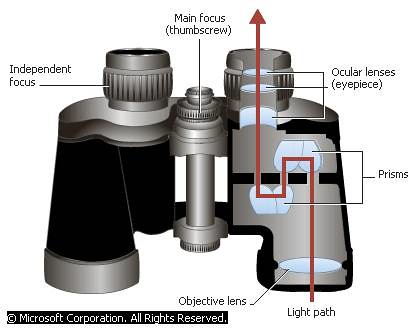
Binoculars
Amateur astronomers can get a clear view of some astronomical objects even without a telescope. Binoculars can make features on the Moon visible and reveal some detail in more distant objects such as nebulas and some of the planets.
© Microsoft Corporation. All Rights Reserved.
Astronomers use tools such as telescopes, cameras, spectrographs, and computers to analyze the light that astronomical objects emit. Amateur astronomers observe the sky as a hobby, while professional astronomers are paid for their research and usually work for large institutions such as colleges, universities, observatories, and government research institutes. Amateur astronomers make valuable observations, but are often limited by lack of access to the powerful and expensive equipment of professional astronomers.
A wide range of astronomical objects is accessible to amateur astronomers. Many solar system objects—such as planets, moons, and comets—are bright enough to be visible through binoculars and small telescopes. Small telescopes are also sufficient to reveal some of the beautiful detail in nebulas—clouds of gas and dust in our Milky Way Galaxy. Many amateur astronomers observe and photograph these objects. The increasing availability of sophisticated electronic instruments and computers over the past few decades has made powerful equipment more affordable and allowed amateur astronomers to expand their observations to much fainter objects. Amateur astronomers sometimes share their observations by posting their photographs on the World Wide Web, a network of information based on connections between computers.
Amateurs often undertake projects that require numerous observations over days, weeks, months, or even years. By searching the sky over a long period of time, amateur astronomers may observe things in the sky that represent sudden change, such as new comets or novas (stars that brighten suddenly). This type of consistent observation is also useful for studying objects that change slowly over time, such as variable stars and double stars. Amateur astronomers observe meteor showers, sunspots, and groupings of planets and the Moon in the sky. They also participate in expeditions to places in which special astronomical events—such as solar eclipses and meteor showers—are most visible. Several organizations, such as the Astronomical League and the American Association of Variable Star Observers, provide meetings and publications through which amateur astronomers can communicate and share their observations.
| III |
| HOW ASTRONOMERS WORK |
 Electromagnetic Spectrum
Electromagnetic SpectrumThe electromagnetic spectrum is a range of energetic radiation that includes radio waves, microwaves, infrared light, visible light, ultraviolet light, X rays, and gamma rays. Visible light, which makes up only a tiny fraction of the electromagnetic spectrum, is the only electromagnetic radiation that humans can perceive with their eyes. Astronomers examine radiation of all wavelenghts emitted by a celestial body.
© Microsoft Corporation. All Rights Reserved.
Professional astronomers usually have access to powerful telescopes, detectors, and computers. Most work in astronomy includes three parts, or phases. Astronomers first observe astronomical objects by guiding telescopes and instruments to collect the appropriate information. Astronomers then analyze the images and data. After the analysis, they compare their results with existing theories to determine whether their observations match with what theories predict, or whether the theories can be improved. Some astronomers work solely on observation and analysis, and some work solely on developing new theories.
Astronomy is such a broad topic that astronomers specialize in one or more parts of the field. For example, the study of the solar system is a different area of specialization than the study of stars. Astronomers who study our galaxy, the Milky Way, often use techniques different from those used by astronomers who study distant galaxies. Many planetary astronomers, such as scientists who study Mars, may have geology backgrounds and not consider themselves astronomers at all. Solar astronomers use different telescopes than nighttime astronomers use, because the Sun is so bright. Theoretical astronomers may never use telescopes at all. Instead, these astronomers use existing data or sometimes only previous theoretical results to develop and test theories. An increasing field of astronomy is computational astronomy, in which astronomers use computers to simulate astronomical events. Examples of events for which simulations are useful include the formation of the earliest galaxies of the universe or the explosion of a star to make a supernova.
Astronomers learn about astronomical objects by observing the energy they emit. These objects emit energy in the form of electromagnetic radiation. This radiation travels throughout the universe in the form of waves and can range from gamma rays, which have extremely short wavelengths, to visible light, to radio waves, which are very long. The entire range of these different wavelengths makes up the electromagnetic spectrum.
Astronomers gather different wavelengths of electromagnetic radiation depending on the objects that are being studied. The techniques of astronomy are often very different for studying different wavelengths. Conventional telescopes work only for visible light and the parts of the spectrum near visible light, such as the shortest infrared wavelengths and the longest ultraviolet wavelengths. Earth’s atmosphere complicates studies by absorbing many wavelengths of the electromagnetic spectrum. gamma-ray astronomy, X-ray astronomy, infrared astronomy, ultraviolet astronomy, radio astronomy, visible-light astronomy, cosmic-ray astronomy, gravitational-wave astronomy, and neutrino astronomy all use different instruments and techniques.
| A |
| Observation |
Observational astronomers use telescopes or other instruments to observe the heavens. The astronomers who do the most observing, however, probably spend more time using computers than they do using telescopes. A few nights of observing with a telescope often provide enough data to keep astronomers busy for months analyzing the data.
| A1 |
| Optical Astronomy |
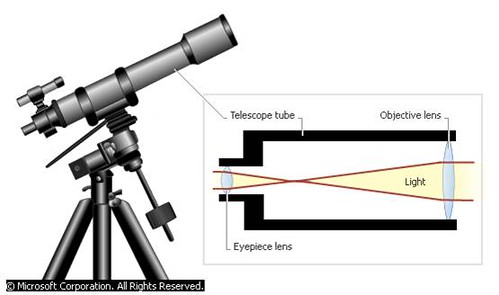
Refracting Telescope
The simplest refracting telescope has two convex lenses, which are thicker in the middle than at the edges. The lens closest to the object is called the objective lens. This lens collects light from a distant source and brings it to a focus as an upside-down image within the telescope tube. The eyepiece lens forms an image that remains inverted. More complex refracting telescopes contain an additional lens to flip the image right-side up.
© Microsoft Corporation. All Rights Reserved.
Until the 20th century, all observational astronomers studied the visible light that astronomical objects emit. Such astronomers are called optical astronomers, because they observe the same part of the electromagnetic spectrum that the human eye sees. Optical astronomers use telescopes and imaging equipment to study light from objects. Professional astronomers today hardly ever actually look through telescopes. Instead, a telescope sends an object’s light to a photographic plate or to an electronic light-sensitive computer chip called a charge-coupled device, or CCD. CCDs are about 50 times more sensitive than film, so today's astronomers can record in a minute an image that would have taken about an hour to record on film.
Reflecting Telescope
A reflecting telescope uses a curved mirror to focus light. Light from distant objects, such as stars and galaxies, enters the telescope tube in parallel rays. These rays are reflected from the concave objective mirror to a diagonal flat mirror. The diagonal mirror reflects the light through a hole in the side of the telescope tube to a lens in the eyepiece.
© Microsoft Corporation. All Rights Reserved.
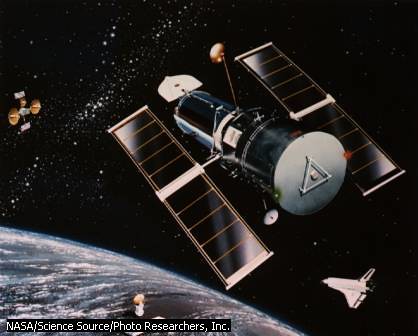
Hubble Space Telescope
The Hubble Space Telescope, free of the distorting effects of Earth’s atmosphere, has an unprecedented view of distant galaxies. The telescope is capable of recording information in various wavelengths, but its optical telescope has produced some of the most spectacular results. It has revealed some of the most distant and oldest galaxies in the universe and helped astronomers get a clearer picture of our solar system
NASA/Science Source/Photo Researchers, Inc.
The Hubble Space Telescope (HST), a reflecting telescope that orbits Earth, has returned the clearest images of any optical telescope. The main mirror of the HST is only 94 in (2.4 m) across, far smaller than that of the largest ground-based reflecting telescopes. Turbulence in the atmosphere makes observing objects as clearly as the HST can see impossible for ground-based telescopes. HST images of visible light are about five times finer than any produced by ground-based telescopes. Giant telescopes on Earth, however, collect much more light than the HST can. Examples of such giant telescopes include the twin 32-ft (10-m) Keck telescopes in Hawaii and the four 26-ft (8-m) telescopes in the Very Large Telescope array in the Atacama Desert in northern Chile (the nearest city is Antofagasta, Chile). Often astronomers use space- and ground-based telescopes in conjunction. See also Space Telescope.
Astronomers usually share telescopes. Many institutions with large telescopes accept applications from any astronomer who wishes to use the instruments, though others have limited sets of eligible applicants. The institution then divides the available time among successful applicants and assigns each astronomer an observing period. Astronomers can collect data from telescopes remotely. Data from Earth-based telescopes can be sent electronically over computer networks. Data from space-based telescopes reach Earth through radio waves collected by antennas on the ground.
| A2 |
| Gamma-Ray and X-Ray Astronomy |
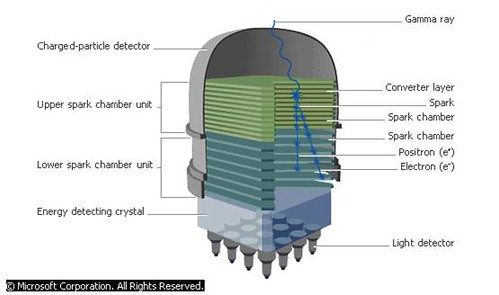
Gamma-Ray Telescope
A gamma-ray telescope detects radiation that has a shorter wavelength than visible light. Gamma rays enter the telescope through the charged-particle detector and pass into layers of material that transform the gamma rays into electrons and positrons. The electrons and positrons have electric charges, which cause sparks as the particles pass through the spark chambers in the lower part of the telescope. Light detectors at the bottom of the telescope record the sparks.
© Microsoft Corporation. All Rights Reserved.
Gamma rays have the shortest wavelengths. Special telescopes in orbit around Earth, such as the National Aeronautics and Space Administration’s (NASA’s) Compton Gamma-Ray Observatory, gather gamma rays before Earth’s atmosphere absorbs them. X rays, the next shortest wavelengths, also must be observed from space. NASA’s Chandra X-Ray Observatory (CXO) is a school-bus-sized spacecraft that began studying X rays from orbit in 1999. See also Gamma-Ray Astronomy; X-Ray Astronomy.
| A3 |
| Ultraviolet Astronomy |
Ultraviolet light has wavelengths longer than X rays, but shorter than visible light. Ultraviolet telescopes are similar to visible-light telescopes in the way they gather light, but the atmosphere blocks most ultraviolet radiation. Most ultraviolet observations, therefore, must also take place in space. Most of the instruments on the Hubble Space Telescope (HST) are sensitive to ultraviolet radiation (see Ultraviolet Astronomy). Humans cannot see ultraviolet radiation, but astronomers can create visual images from ultraviolet light by assigning particular colors or shades to different intensities of radiation.
| A4 |
| Infrared Astronomy |

Infrared Telescope
Infrared telescopes detect radiation that has wavelengths longer than the light that humans can see. Infrared radiation enters the telescope and reflects off of a large mirror on the bottom of the telescope, then off of a smaller mirror. Detectors and instruments beneath the mirrors record the radiation. Infrared telescopes must be kept at very low temperatures to prevent their own heat from producing infrared radiation that could interfere with observations.
© Microsoft Corporation. All Rights Reserved.
Infrared astronomers study parts of the infrared spectrum, which consists of electromagnetic waves with wavelengths ranging from just longer than visible light to 1,000 times longer than visible light. Earth’s atmosphere absorbs infrared radiation, so astronomers must collect infrared radiation from places where the atmosphere is very thin, or from above the atmosphere. Observatories for these wavelengths are located on certain high mountaintops or in space (see Infrared Astronomy). Most infrared wavelengths can be observed only from space. Every warm object emits some infrared radiation. Infrared astronomy is useful because objects that are not hot enough to emit visible or ultraviolet radiation may still emit infrared radiation. Infrared radiation also passes through interstellar and intergalactic gas and dust more easily than radiation with shorter wavelengths. Further, the brightest part of the spectrum from the farthest galaxies in the universe is shifted into the infrared.
| A5 |
| Radio Astronomy |

Radio Telescopes
The Very Large Array is a collection of parabolic dish antennas, located near Socorro, New Mexico. The 27 antennas are attached to a system of Y-shaped tracks; each track is 21 km (13 mi) in length. The individual signals from each telescope are combined into one high-resolution image, making the array the world's largest radio telescope.
© Microsoft Corporation. All Rights Reserved.
Radio waves have the longest wavelengths. Radio astronomers use giant dish antennas to collect and focus signals in the radio part of the spectrum (see Radio Astronomy). These celestial radio signals, often from hot bodies in space or from objects with strong magnetic fields, come through Earth's atmosphere to the ground. Radio waves penetrate dust clouds, allowing astronomers to see into the center of our galaxy and into the cocoons of dust that surround forming stars.
| A6 |
| Study of Other Emissions |
Sometimes astronomers study emissions from space that are not electromagnetic radiation. Some of the particles of interest to astronomers are neutrinos, cosmic rays, and gravitational waves. Neutrinos are tiny particles with no electric charge and very little or no mass. All stars emit neutrinos, but neutrino detectors on Earth receive neutrinos only from the Sun and supernovas. Most neutrino telescopes consist of huge underground tanks of liquid. These tanks capture a few of the many neutrinos that strike them, while the vast majority of neutrinos pass right through the tanks.
Cosmic rays are electrically charged particles that come to Earth from outer space at almost the speed of light. They are made up of negatively charged particles called electrons and positively charged nuclei of atoms. Astronomers do not know where most cosmic rays come from, but they use cosmic-ray detectors to study the particles. Cosmic-ray detectors are usually grids of wires that produce an electrical signal when a cosmic ray passes close to them.
Gravitational waves are a predicted consequence of the general theory of relativity developed by German-born American physicist Albert Einstein. Since the 1960s astronomers have been building detectors for gravitational waves. Older gravitational-wave detectors were huge instruments that surrounded a carefully measured and positioned massive object suspended from the top of the instrument. Lasers trained on the object were designed to measure the object’s movement, which theoretically would occur when a gravitational wave hit the object. No gravitational waves have yet been detected. Gravitational waves should be very weak, and the instruments are probably not yet sensitive enough to register them. In the 1970s and 1980s American physicists Joseph Taylor and Russell Hulse observed indirect evidence of gravitational waves by studying systems of double pulsars. A new generation of gravitational-wave detectors, developed in the 1990s, uses interferometers to measure distortions of space that would be caused by passing gravitational waves.
Some objects emit radiation more strongly in one wavelength than in another, but a set of data across the entire spectrum of electromagnetic radiation is much more useful than observations in any one wavelength. For example, the supernova remnant known as the Crab Nebula has been observed in every part of the spectrum, and astronomers have used all the discoveries together to make a complete picture of how the Crab Nebula is evolving.
| B |
| Analysis and Theory |
Whether astronomers take data from a ground-based telescope or have data radioed to them from space, they must then analyze the data. Usually the data are handled with the aid of a computer, which can carry out various manipulations the astronomer requests. For example, some of the individual picture elements, or pixels, of a CCD may be slightly more sensitive than others. Consequently, astronomers sometimes take images of blank sky to measure which pixels appear brighter. They can then take these variations into account when interpreting the actual celestial images. Astronomers may write their own computer programs to analyze data or, as is increasingly the case, use certain standard computer programs developed at national observatories or elsewhere.
Often an astronomer uses observations to test a specific theory. Sometimes, a new experimental capability allows astronomers to study a new part of the electromagnetic spectrum or to see objects in greater detail or through special filters. If the observations do not verify the predictions of a theory, the theory must be discarded or, if possible, modified.
| IV |
| EARTH'S NIGHT SKY |
Up to about 3,000 stars are visible at a time from Earth with the unaided eye, far away from city lights, on a clear night. A view at night may also show several planets and perhaps a comet or a meteor shower. Increasingly, human-made light pollution is making the sky less dark, limiting the number of visible astronomical objects. During the daytime the Sun shines brightly. The Moon and bright planets are sometimes visible early or late in the day but are rarely seen at midday.
| A |
| Earth's Relative Motion |
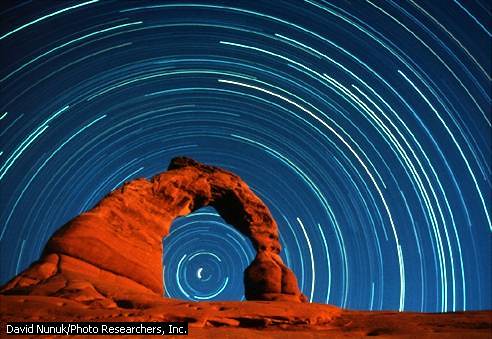
Star Trails
This long-exposure photograph shows the Delicate Arch, a rock formation in Utah, silhouetted against the trails of stars in the sky. The brightest and innermost trail, seen through the center of the arch, tracks the North Star. The North Star is the star located closest to the north celestial pole of the Earth’s axis. It appears to rotate very little while the other stars move around it. This apparent motion is actually caused by the rotation of Earth.
David Nunuk/Photo Researchers, Inc.
Earth moves in two basic ways: It turns in place, and it revolves around the Sun. Earth turns around its axis, an imaginary line that runs down its center through its North and South poles. The Moon also revolves around Earth. All of these motions produce day and night, the seasons, the phases of the Moon, and solar and lunar eclipses.
| A1 |
| Night, Day, and Seasons |

Seasons
© Microsoft Corporation. All Rights Reserved.
Earth is about 12,000 km (about 7,000 mi) in diameter. As it revolves, or moves in a circle, around the Sun, Earth spins on its axis. This spinning movement is called rotation. Earth’s axis is tilted 23.5° with respect to the plane of its orbit. Each time Earth rotates on its axis, it goes through one day, a cycle of light and dark. Humans artificially divide the day into 24 hours and then divide the hours into 60 minutes and the minutes into 60 seconds.
Earth revolves around the Sun once every year, or 365.25 days (most people use a 365-day calendar and take care of the extra 0.25 day by adding a day to the calendar every four years, creating a leap year). The orbit of Earth is almost, but not quite, a circle, so Earth is sometimes a little closer to the Sun than at other times. If Earth were upright as it revolved around the Sun, each point on Earth would have exactly 12 hours of light and 12 hours of dark each day. Because Earth is tilted, however, the northern hemisphere sometimes points toward the Sun and sometimes points away from the Sun. This tilt is responsible for the seasons. When the northern hemisphere points toward the Sun, the northernmost regions of Earth see the Sun 24 hours a day. The whole northern hemisphere gets more sunlight and gets it at a more direct angle than the southern hemisphere does during this period, which lasts for half of the year. The second half of this period, when the northern hemisphere points most directly at the Sun, is the northern hemisphere's summer, which corresponds to winter in the southern hemisphere. During the other half of the year, the southern hemisphere points more directly toward the Sun, so it is spring and summer in the southern hemisphere and fall and winter in the northern hemisphere.
| A2 |
| Phases of the Moon |
One revolution of the Moon around Earth takes a little over 27 days 7 hours. The Moon rotates on its axis in this same period of time, so the same face of the Moon is always presented to Earth. Over a period a little longer than 29 days 12 hours, the Moon goes through a series of phases, in which the amount of the lighted half of the Moon we see from Earth changes. These phases are caused by the changing angle of sunlight hitting the Moon. (The period of phases is longer than the period of revolution of the Moon, because the motion of Earth around the Sun changes the angle at which the Sun’s light hits the Moon from night to night.)
The Moon’s orbit around Earth is tilted 5° from the plane of Earth’s orbit. Because of this tilt, when the Moon is at the point in its orbit when it is between Earth and the Sun, the Moon is usually a little above or below the Sun. At that time, the Sun lights the side of the Moon facing away from Earth, and the side of the Moon facing toward Earth is dark. This point in the Moon’s orbit corresponds to a phase of the Moon called the new moon. A quarter moon occurs when the Moon is at right angles to the line formed by the Sun and Earth. The Sun lights the side of the Moon closest to it, and half of that side is visible from Earth, forming a bright half-circle. When the Moon is on the opposite side of Earth from the Sun, the face of the Moon visible from Earth is lit, showing the full moon in the sky.
| A3 |
| Eclipses |
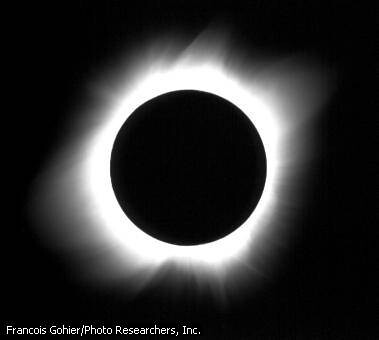
Total Solar Eclipse
During a solar eclipse, the Moon moves between the Sun and Earth. The light from the outer part of the Sun’s atmosphere, called the corona, became visible during a total solar eclipse on July 11, 1991, in La Paz, Baja California, Mexico. The Moon’s shadow on Earth appeared only as a thin band not more than 269 km (167 mi) wide.
Francois Gohier/Photo Researchers, Inc.
A total solar eclipse is visible from only a small region of Earth. During a solar eclipse, the complete shadow of the Moon that falls on Earth is only about 160 km (about 100 mi) wide. As Earth, the Sun, and the Moon move, however, the Moon’s shadow sweeps out a path up to 16,000 km (10,000 mi) long. The total eclipse can only be seen from within this path. A total solar eclipse occurs about every 18 months. Off to the sides of the path of a total eclipse, a partial eclipse, in which the Sun is only partly covered, is visible. Partial eclipses are much less dramatic than total eclipses. The Moon’s orbit around Earth is slightly elliptical, or egg-shaped. The distance between Earth and the Moon varies slightly as the Moon orbits Earth. When the Moon is farther from Earth than usual, it appears smaller and may not cover the entire Sun during an eclipse. A ring, or annulus, of sunlight remains visible, making an annular eclipse. An annular solar eclipse also occurs about every 18 months. Additional partial solar eclipses are also visible from Earth in between.
At a lunar eclipse, the Moon is actually in Earth's shadow. When the Moon is completely in the shadow, the total lunar eclipse is visible from everywhere on the half of Earth from which the Moon is visible at that time. As a result, more people see total lunar eclipses than see total solar eclipses.
| B |
| Meteors |
In an open place on a clear dark night, streaks of light may appear in a random part of the sky about once every 10 minutes. These streaks are meteors—bits of rock—burning up in Earth's atmosphere. The bits of rock are called meteoroids, and when these bits survive Earth’s atmosphere intact and land on Earth, they are known as meteorites.
Every month or so, Earth passes through the orbit of a comet. Dust from the comet remains in the comet's orbit. When Earth passes through the band of dust, the dust and bits of rock burn up in the atmosphere, creating a meteor shower. Many more meteors are visible during a meteor shower than on an ordinary night. The most observed meteor shower is the Perseid shower (see Perseids), which occurs each year on August 11th or 12th.
| C |
| Mapping the Sky |
Humans have picked out landmarks in the sky and mapped the heavens for thousands of years. Maps of the sky helped people navigate, measure time, and track celestial events. Now astronomers methodically map the sky to produce a universal format for the addresses of stars, galaxies, and other objects of interest.
| C1 |
| The Constellations |

Constellation Names and Meanings
Ancient people and astronomers often saw designs or groupings in the stars and named them after various religious figures, animals, and objects. This table lists some of the more prominent constellations and translates their names.
© Microsoft Corporation. All Rights Reserved.
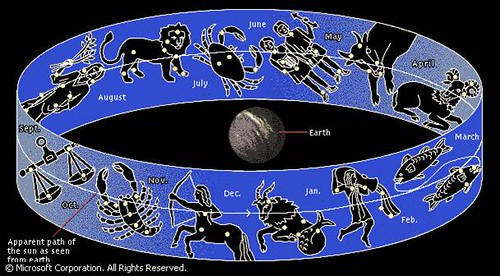
Constellations of the Zodiac
Ancient astronomers noted that the Sun makes a yearly journey across the celestial sphere, part of which is represented in this picture by the blue band. The ancient astronomers associated dates with the constellations in this narrow belt (which is known as the zodiac), assigning to each constellation of stars the dates when the Sun was in the same region of the celestial sphere as the constellation. The twelve zodiacal signs for these constellations were named by the 2nd-century astronomer Ptolemy, as follows: Aries (ram), Taurus (bull), Gemini (twins), Cancer (crab), Leo (lion), Virgo (virgin), Libra (balance), Scorpio (scorpion), Sagittarius (archer), Capricorn (goat), Aquarius (water-bearer), and Pisces (fishes).
© Microsoft Corporation. All Rights Reserved.
A familiar group of stars in the northern hemisphere is called the Big Dipper. The Big Dipper is actually part of an official constellation—Ursa Major, or the Great Bear. Groups of stars that are not official constellations, such as the Big Dipper, are called asterisms. While the stars in the Big Dipper appear in approximately the same part of the sky, they vary greatly in their distance from Earth. This is true for the stars in all constellations or asterisms—the stars making up the group do not really occur close to each other in space; they merely appear together as seen from Earth. The patterns of the constellations are figments of humans’ imagination, and different artists may connect the stars of a constellation in different ways, even when illustrating the same myth.
| C2 |
| Coordinate Systems |
Astronomers use coordinate systems to label the positions of objects in the sky, just as geographers use longitude and latitude to label the positions of objects on Earth. Astronomers use several different coordinate systems. The two most widely used are the altazimuth system and the equatorial system. The altazimuth system gives an object’s coordinates with respect to the sky visible above the observer. The equatorial coordinate system designates an object’s location with respect to Earth’s entire night sky, or the celestial sphere.
| C2a |
| Altazimuth System |
One of the ways astronomers give the position of a celestial object is by specifying its altitude and its azimuth. This coordinate system is called the altazimuth system. The altitude of an object is equal to its angle, in degrees, above the horizon. An object at the horizon would have an altitude of 0°, and an object directly overhead would have an altitude of 90°. The azimuth of an object is equal to its angle in the horizontal direction, with north at 0°, east at 90°, south at 180°, and west at 270°. For example, if an astronomer were looking for an object at 23° altitude and 87° azimuth, the astronomer would know to look fairly low in the sky and almost directly east.
As Earth rotates, astronomical objects appear to rise and set, so their altitudes and azimuths are constantly changing. An object’s altitude and azimuth also vary according to an observer’s location on Earth. Therefore, astronomers almost never use altazimuth coordinates to record an object’s position. Instead, astronomers with altazimuth telescopes translate coordinates from equatorial coordinates to find an object. Telescopes that use an altazimuth mounting system may be simple to set up, but they require many calculated movements to keep them pointed at an object as it moves across the sky. These telescopes fell out of use with the development of the equatorial coordinate and mounting system in the early 1800s. However, computers have made the return to popularity possible for altazimuth systems. Altazimuth mounting systems are simple and inexpensive, and—with computers to do the required calculations and control the motor that moves the telescope—they are practical.
| C2b |
| Equatorial System |
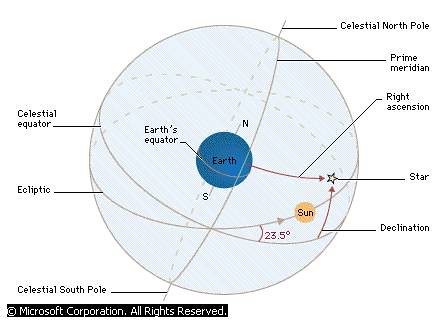
Celestial Sphere
The celestial sphere is an imaginary globe surrounding Earth. Astronomers give stars coordinates from the globe to locate them just as geographers give latitude and longitude coordinates to places on Earth. Right ascension is the celestial equivalent of longitude, and declination is celestial equivalent of latitude.
© Microsoft Corporation. All Rights Reserved.
The equatorial coordinate system is a coordinate system fixed on the sky. In this system, a star keeps the same coordinates no matter what the time is or where the observer is located. The equatorial coordinate system is based on the celestial sphere. The celestial sphere is a giant imaginary globe surrounding Earth. This sphere has north and south celestial poles directly above Earth’s North and South poles. It has a celestial equator, directly above Earth’s equator. Another important part of the celestial sphere is the line that marks the movement of the Sun with respect to the stars throughout the year. This path is called the ecliptic. Because Earth is tilted with respect to its orbit around the Sun, the ecliptic is not the same as the celestial equator. The ecliptic is tilted 23.5° to the celestial equator and crosses the celestial equator at two points on opposite sides of the celestial sphere. The crossing points are called the vernal (or spring) equinox and the autumnal equinox. The vernal equinox and autumnal equinox mark the beginning of spring and fall, respectively. The points at which the ecliptic and celestial equator are farthest apart are called the summer solstice and the winter solstice, which mark the beginning of summer and winter, respectively.
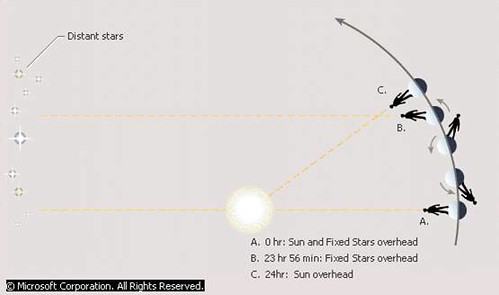
Sidereal Time
Scientists use stars as reference points to measure the time it takes Earth to make one full rotation on its axis. When the sun is used as a reference, the rotation is called a mean solar day. When scientists use a fixed star other than the sun as a reference point, the rotation is called a sidereal day. A sidereal day is 4 minutes shorter than the mean solar day.
© Microsoft Corporation. All Rights Reserved.
The equivalent of longitude on the celestial sphere is called right ascension and the equivalent of latitude is declination. Specifying the right ascension of a star is equivalent to measuring the east-west distance from a line called the prime meridian that runs through Greenwich, England, for a place on Earth. Right ascension starts at the vernal equinox. Longitude on Earth is given in degrees, but right ascension is given in units of time—hours, minutes, and seconds. This is because the celestial equator is divided into 24 equal parts—each called an hour of right ascension instead of 15°. Each hour is made up of 60 minutes, each of which is equal to 60 seconds. Measuring right ascension in units of time makes determining when will be the best time for observing an object easier for astronomers. A particular line of right ascension will be at its highest point in the sky above a particular place on Earth four minutes earlier each day, so keeping track of the movement of the celestial sphere with an ordinary clock would be complicated. Astronomers have special clocks that keep sidereal time (24 sidereal hours are equal to 23 hours 56 minutes of familiar solar time). Astronomers compare the current sidereal time to the right ascension of the object they wish to view. The object will be highest in the sky when the sidereal time equals the right ascension of the object.
The direction perpendicular to right ascension—and the equivalent to latitude on Earth—is declination. Declination is measured in degrees. These degrees are divided into arcminutes and arcseconds. One arcminute is equal to 1/60 of a degree, and one arcsecond is equal to 1/60 of an arcminute, or 1/360 of a degree. The celestial equator is at declination 0°, the north celestial pole is at declination 90°, and the south celestial pole has a declination of –90°. Each star has a right ascension and a declination that mark its position in the sky. The brightest star, Sirius, for example, has right ascension 6 hours 45 minutes (abbreviated as 6h 45m) and declination -16 degrees 43 arcminutes (written –16° 43').
Stars are so far away from Earth that the main star motion we see results from Earth’s rotation. Stars do move in space, however, and these proper motions slightly change the coordinates of the nearest stars over time. The effects of the Sun and the Moon on Earth also cause slight changes in Earth’s axis of rotation. These changes, called precession, cause a slow drift in right ascension and declination. To account for precession, astronomers redefine the celestial coordinates every 50 years or so.
| V |
| THE SOLAR SYSTEM |
Solar systems, both our own and those located around other stars, are a major area of research for astronomers. A solar system consists of a central star orbited by planets or smaller rocky bodies. The gravitational force of the star holds the system together. In our solar system, the central star is the Sun. It holds all the planets, including Earth, in their orbits and provides light and energy necessary for life. Our solar system is just one of many. Astronomers are just beginning to be able to study other solar systems. See also Extrasolar Planets.
| A |
| Objects in Our Solar System |
Our solar system contains the Sun, nine planets (of which Earth is third from the Sun), and the planets’ satellites. It also contains asteroids, comets, and interplanetary dust and gas.
| A1 |
| Planets and Their Satellites |

Mercury
Mercury orbits closer to the Sun than any other planet, making it dry, hot, and virtually airless. Although the planet’s cratered surface resembles that of the Moon, it is believed that the interior is actually similar to Earth’s, consisting primarily of iron and other heavy elements. This composite photograph was taken in 1974 by Mariner 10, the first probe to study Mercury in detail.
NASA/Science Source/Photo Researchers, Inc.
Until the end of the 18th century, humans knew of five planets—Mercury, Venus, Mars, Jupiter, and Saturn—in addition to Earth. When viewed without a telescope, planets appear to be dots of light in the sky. They shine steadily, while stars seem to twinkle. Twinkling results from turbulence in Earth's atmosphere. Stars are so far away that they appear as tiny points of light. A moment of turbulence can change that light for a fraction of a second. Even though they look the same size as stars to unaided human eyes, planets are close enough that they take up more space in the sky than stars do. The disks of planets are big enough to average out variations in light caused by turbulence and therefore do not twinkle.

Solar System
© Microsoft Corporation. All Rights Reserved.

Uranus and its Moons
The planet Uranus (the bright blue object) is surrounded by its five largest satellites clockwise from top left, Ariel, Umbriel, Oberon, Titania, and Miranda, in this collage created from photographs taken by the United States Voyager 2 spacecraft in 1986.
NASA
Pluto, the outermost planet, is tiny, with a mass about one five-hundredth the mass of Earth. Pluto seems out of place, with its tiny, solid body out beyond the giant planets. Many astronomers believe that Pluto is just one of a group of icy objects in the outer solar system. These objects orbit in a part of the solar system called the Kuiper Belt. Even if astronomers decide that Pluto belongs to the Kuiper Belt objects, it will probably still be called a planet for historical reasons.
Most of the planets have moons, or satellites. Earth's Moon has a diameter about one-fourth the diameter of Earth. Mars has two tiny chunks of rock, Phobos and Deimos, each only about 10 km (about 6 mi) across. Jupiter has more than 60 satellites. The largest four, known as the Galilean satellites, are Io, Europa, Ganymede, and Callisto. Ganymede is even larger than the planet Mercury. Saturn has more than 40 satellites. Saturn’s largest moon, Titan, is also larger than the planet Mercury and is enshrouded by a thick, opaque, smoggy atmosphere. Uranus has nearly 30 known moons, and Neptune has at least 13 moons. Pluto has three moons; the largest is called Charon. Charon is more than half as big as Pluto.
| A2 |
| Comets and Asteroids |
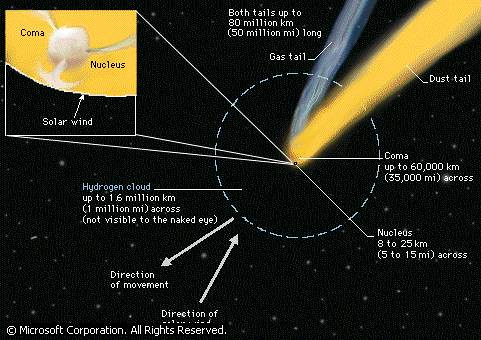
Structure of a Comet
As a comet approaches the Sun, ice begins to boil, releasing dust and gas from the rocky nucleus. The dust and gas create tails millions of times larger than the nucleus. The tails of some comets are large enough and reflect enough light to be visible from Earth.
© Microsoft Corporation. All Rights Reserved.
Comets and asteroids are rocky and icy bodies that are smaller than planets. The distinction between comets, asteroids, and other small bodies in the solar system is a little fuzzy, but generally a comet is icier than an asteroid and has a more elongated orbit. The orbit of a comet takes it close to the Sun, then back into the outer solar system. When comets near the Sun, some of their ice turns from solid material into gas, releasing some of their dust. Comets have long tails of glowing gas and dust when they are near the Sun. Asteroids are rockier bodies and usually have orbits that keep them at always about the same distance from the Sun.

Three Asteroids
Asteroid Mathilde, left, is the third and the largest asteroid ever to be viewed at close range. The Near Earth Asteroid Rendezvous (NEAR) spacecraft flew by Mathilde in late June 1997. Asteroids Gaspra and Ida, center and right, photographed by the Galileo orbiter in 1991 and 1993, respectively, are smaller and more oblong-shaped than Mathilde. The three asteroids are partially obscured by shadows.
The Johns Hopkins University Applied Physics Laboratory
When the solar system was forming, some of the planetesimals came together more toward the center of the solar system. Gravitational forces from the giant planet Jupiter prevented these planetesimals from forming full-fledged planets. Instead, the planetesimals broke up to create thousands of minor planets, or asteroids, that orbit the Sun. Most of them are in the asteroid belt, between the orbits of Mars and Jupiter, but thousands are in orbits that come closer to Earth or even cross Earth's orbit. Scientists are increasingly aware of potential catastrophes if any of the largest of these asteroids hits Earth. Perhaps 2,000 asteroids larger than 1 km (0.6 mi) in diameter are potential hazards.
| A3 |
| The Sun |
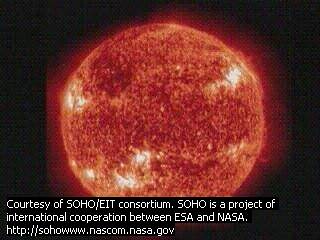
Solar Chromosphere
The chromosphere is a layer of the Sun’s atmosphere. Astronomers cannot see it in ordinary visible light, so they use instruments that detect other wavelengths of light, then transform the data into pictures that they can see. Astronomers using the European Solar and Heliospheric Observatory (SOHO) used such a process to obtain these images.
Courtesy of SOHO/EIT consortium. SOHO is a project of international cooperation between ESA and NASA. http://sohowww.nascom.nasa.gov
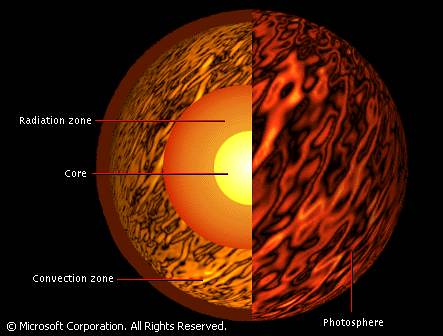
Interior of the Sun
Regions of the Sun include the core, radiation zone, convection zone, and photosphere. Gases in the core are about 150 times as dense as water and reach temperatures as high as 16 million degrees C (29 million degrees F). The Sun’s energy is produced in the core through nuclear fusion of hydrogen atoms into helium. In the radiation zone, heat flows outward through gases that are about as dense as water. The radiation zone is cooler than the core, about 2.5 million degrees C (4.5 million degrees F). In the convection zone, churning motions of the gases carry the Sun’s energy further outward. The convection zone is slightly cooler, about 2 million degrees C (3.6 million degrees F), and less dense, about one-tenth as dense as water. The photosphere is much cooler, about 5500° C (10,000° F) and much less dense, about one-millionth that of water. The turbulence of this region is visible from earth in the form of sunspots, solar flares, and small patches of gas called granules.
© Microsoft Corporation. All Rights Reserved.
The Sun produces its energy by fusing hydrogen into helium in a process called nuclear fusion. In nuclear fusion, two atoms merge to form a heavier atom and release energy (see Nuclear Energy: Nuclear Fusion). The Sun and stars of similar mass start off with enough hydrogen to shine for about 10 billion years. The Sun is less than halfway through its lifetime.
| B |
| Studying the Solar System |
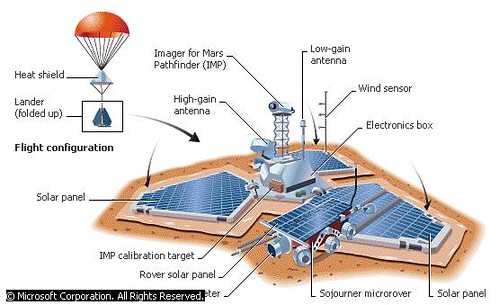
Mars Pathfinder Spacecraft
The Mars Pathfinder spacecraft, launched by the United States in 1997, was made up of a lander containing weather equipment and cameras, and a small rover, which explored the surface of Mars around the lander. The lander folded up around the equipment and the rover for the journey to Mars, then unfolded when it reached the planet's surface.
© Microsoft Corporation. All Rights Reserved.

Sun in X-Ray Wavelengths
Nuclear reactions within the Sun produce extremely hot gasses that emit X rays. The Sun’s magnetic field captures some of these gases and holds them in the Sun’s corona, or outer atmosphere. In this X-ray photograph of the Sun, regions in which the Sun’s magnetic field is strong and can hold more X-ray producing gas are bright, while less active regions are dark.
Science Source/Photo Researchers, Inc.
During the space age, scientists have developed telescopes and other devices, such as instruments to measure magnetic fields or space dust, that can leave Earth's surface and travel close to other objects in the solar system. Robotic spacecraft have visited all of the planets in the solar system except Pluto. Some missions have targeted specific planets and spent much time studying a single planet, and some spacecraft have flown past a number of planets.
Astronomers use different telescopes to study the Sun than they use for nighttime studies because of the extreme brightness of the Sun. Telescopes in space, such as the Solar and Heliospheric Observatory (SOHO) and the Transition Region and Coronal Explorer (TRACE), are able to study the Sun in regions of the spectrum other than visible light. X rays, ultraviolet, and radio waves from the Sun are especially interesting to astronomers. Studies in various parts of the spectrum give insight into giant flows of gas in the Sun, into how the Sun's energy leaves the Sun to travel to Earth, and into what the interior of the Sun is like. Astronomers also study solar-terrestrial relations—the relation of activity on the Sun with magnetic storms and other effects on Earth. Some of these storms and effects can affect radio reception, cause electrical blackouts, or damage satellites in orbit.
| C |
| Solar System Formation |
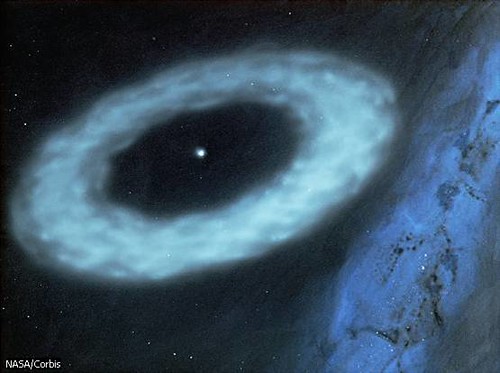
Vega’s Solar System
In 1983 astronomers discovered that the star Vega is surrounded by a disk of small particles, probably dust, rock, and ice. Vega is the first star other than the Sun known to be orbited by such a disk. Astronomers believe that our solar system probably began as a disk like Vega’s. This artist's rendering shows how Vega may look.
NASA/Corbis
Our solar system began forming about 5 billion years ago, when a cloud of gas and dust between the stars in our Milky Way Galaxy began contracting. A nearby supernova—an exploding star—may have started the contraction, but most astronomers believe a random change in density in the cloud caused the contraction. Once the cloud—known as the solar nebula—began to contract, the contraction occurred faster and faster. The gravitational energy caused by this contraction heated the solar nebula. As the cloud became smaller, it began to spin faster, much as a spinning skater will spin faster by pulling in his or her arms. This spin kept the nebula from forming a sphere; instead, it settled into a disk of gas and dust.
In this disk, small regions of gas and dust began to draw closer and stick together. The objects that resulted, which were usually less than 500 km (300 mi) across, are the planetesimals. Eventually, some planetesimals stuck together and grew to form the planets. Scientists have made computer models of how they believe the early solar system behaved. The models show that for a solar system to produce one or two huge planets like Jupiter and several other, much smaller planets is not unusual.
The largest region of gas and dust wound up in the center of the nebula and formed the protosun (proto is Greek for “before” and is used to distinguish between an object and its forerunner). The increasing temperature and pressure in the middle of the protosun vaporized the dust and eventually allowed nuclear fusion to begin, marking the formation of the Sun. The young Sun gave off a strong solar wind that drove off most of the lighter elements, such as hydrogen and helium, from the inner planets. The inner planets then solidified and formed rocky surfaces. The solar wind lost strength. Jupiter’s gravitational pull was strong enough to keep its shroud of hydrogen and helium gas. Saturn, Uranus, and Neptune also kept their layers of light gases.
The theory of solar system formation described above accounts for the appearance of the solar system as we know it. Examples of this appearance include the fact that the planets all orbit the Sun in the same direction and that almost all the planets rotate on their axes in the same direction. The recent discoveries of distant solar systems with different properties could lead to modifications in the theory, however.
Studies in the visible, the infrared, and the shortest radio wavelengths have revealed disks around several young stars in our galaxy. One such object, Beta Pictoris (about 62 light-years from Earth), has revealed a warp in the disk that could be a sign of planets in orbit. Astronomers are hopeful that, in the cases of these young stars, they are studying the early stages of solar system formation.
| D |
| Detecting Other Solar Systems |
Although astronomers have long assumed that many other stars have planets, they have been unable to detect these other solar systems until recently. Planets orbiting around stars other than the Sun are called extrasolar planets. Planets are small and dim compared to stars, so they are lost in the glare of their parent stars and are invisible to direct observation with telescopes.
Astronomers have tried to detect other solar systems by searching for the way a planet affects the movement of its parent star. The gravitational attraction between a planet and its star pulls the star slightly toward the planet, so the star wobbles slightly as the planet orbits it. Throughout the mid- and late 1900s, several observatories tried to detect wobbles in the nearest stars by watching the stars’ movement across the sky. Wobbles were reported in several stars, but later observations showed that the results were false.
In the early 1990s, studies of a pulsar revealed at least two planets orbiting it. Pulsars are compact stars that give off pulses of radio waves at very regular intervals. The pulsar, designated PSR 1257+12, is about 1,000 light-years from Earth. This pulsar's pulses sometimes came a little early and sometimes a little late in a periodic pattern, revealing that an unseen object was pulling the pulsar toward and away from Earth. The environment of a pulsar, which emits X rays and other strong radiation that would be harmful to life on Earth, is so extreme that these objects would have little resemblance to planets in our solar system.
The wobbling of a star changes the star’s light that reaches Earth. When the star moves away from Earth, even slightly, each wave of light must travel farther to Earth than the wave before it. This increases the distance between waves (called the wavelength) as the waves reach Earth. When a star’s planet pulls the star closer to Earth, each successive wavefront has less distance to travel to reach Earth. This shortens the wavelength of the light that reaches Earth. This effect is called the Doppler effect. No star moves fast enough for the change in wavelength to result in a noticeable change in color, which depends on wavelength, but the changes in wavelength can be measured with precise instruments. Because the planet’s effect on the star is very small, astronomers must analyze the starlight carefully to detect a shift in wavelength. They do this by first using a technique called spectroscopy to separate the white starlight into its component colors, as water vapor does to sunlight in a rainbow. Stars emit light in a continuous range. The range of wavelengths a star emits is called the star’s spectrum. This spectrum has dark lines, called absorption lines, at wavelengths at which atoms in the outermost layers of the star absorb light.
Astronomers know what the exact wavelength of each absorption line is for a star that is not moving. By seeing how far the movement of a star shifts the absorption lines in its spectrum, astronomers can calculate how fast the star is moving. If the motion fits the model of the effect of a planet, astronomers can calculate the mass of the planet and how close it is to the star. These calculations can only provide the lower limit to the planet’s mass, because it is impossible for astronomers to tell at what angle the planet orbits the star. Astronomers need to know the angle at which the planet orbits the star to calculate the planet’s mass accurately. Because of this uncertainty, some of the giant extrasolar planets may actually be a type of failed star called a brown dwarf instead of planets. Most astronomers believe that many of the suspected planets are true planets.
Since 1995 astronomers have discovered more than 160 extrasolar planets. Astronomers now know of far more planets outside our solar system than inside our solar system. Most of these planets, surprisingly, are more massive than Jupiter and are orbiting so close to their parent stars that some of them have years (the time it takes to orbit the parent star once) as long as only a few days on Earth. These solar systems are so different from our solar system that astronomers are still trying to reconcile them with the current theory of solar system formation. Some astronomers suggest that the giant extrasolar planets formed much farther away from their stars and were later thrown into the inner solar systems by some gravitational interaction.
| VI |
| STARS |
Stars are an important topic of astronomical research. Stars are balls of gas that shine or used to shine because of nuclear fusion in their cores. The most familiar star is the Sun. The nuclear fusion in stars produces a force that pushes the material in a star outward. However, the gravitational attraction of the star’s material for itself pulls the material inward. A star can remain stable as long as the outward pressure and gravitational force balance. The properties of a star depend on its mass, its temperature, and its stage in evolution.
Astronomers study stars by measuring their brightness or, with more difficulty, their distances from Earth. They measure the “color” of a star—the differences in the star’s brightness from one part of the spectrum to another—to determine its temperature. They also study the spectrum of a star’s light to determine not only the temperature, but also the chemical makeup of the star’s outer layers.
| A |
| Kinds of Stars |

Stellar Evolution
Stars begin life as diffuse clouds of dust and gas. These clouds condense to form stars, after which the stars can develop into a variety of objects, depending on how much matter they contain. Stars that contain more matter experience the effects of gravity more strongly and evolve into dense bodies, such as neutron stars or even black holes.
© Microsoft Corporation. All Rights Reserved.
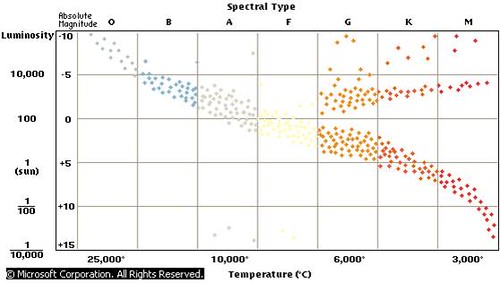
Hertzsprung-Russell Diagram
The H-R diagram compares the brightness of a star with its temperature. The diagonal line running from the upper left to the lower right is called the Main Sequence. Stars lying on the Main Sequence are blue when they are bright and red when they are dim. Stars in the upper right (called Red Giants) are very bright, but still appear red. Stars near the bottom (known as White Dwarfs) are white, but not very bright. This diagram was developed independently by Ejnar Hertzsprung, a Danish astronomer, and Henry Norris Russell, an American astronomer.
© Microsoft Corporation. All Rights Reserved.
In about 1910 Danish astronomer Ejnar Hertzsprung and American astronomer Henry Norris Russell independently worked out a way to graph basic properties of stars. On the horizontal axis of their graphs, they plotted the temperatures of stars. On the vertical axis, they plotted the brightness of stars in a way that allowed the stars to be compared. (One plotted the absolute brightness, or absolute magnitude, of a star, a measurement of brightness that takes into account the distance of the star from Earth. The other plotted stars in a nearby galaxy, all about the same distance from Earth.) The resulting Hertzsprung-Russell diagram, also called an H-R diagram or a color-magnitude diagram (where color relates to temperature), is a basic tool of astronomers.
| A1 |
| Main-Sequence Stars |
On an H-R diagram, the brightest stars are at the top and the hottest stars are at the left. Hertzsprung and Russell found that most stars fell on a diagonal line across the H-R diagram from upper left to lower right. This line is called the main sequence. The diagonal line of main-sequence stars indicates that temperature and brightness of these stars are directly related. The hotter a main-sequence star is, the brighter it is. The Sun is a main-sequence star, located in about the middle of the graph. More faint, cool stars exist than hot, bright ones, so the Sun is brighter and hotter than most of the stars in the universe.
| A2 |
| Giant and Supergiant Stars |
At the upper right of the H-R diagram, above the main sequence, stars are brighter than main-sequence stars of the same color. The only way stars of a certain color can be brighter than other stars of the same color is if the brighter stars are also bigger. Bigger stars are not necessarily more massive, but they do have larger diameters. Stars that fall in the upper right of the H-R diagram are known as giant stars or, for even brighter stars, supergiant stars. Supergiant stars have both larger diameters and larger masses than giant stars.
Giant and supergiant stars represent stages in the lives of stars after they have burned most of their internal hydrogen fuel. Stars swell as they move off the main sequence, becoming giants and—for more massive stars—supergiants.
| A3 |
| White Dwarf Stars |
A few stars fall in the lower left portion of the H-R diagram, below the main sequence. Just as giant stars are larger and brighter than main-sequences stars, these stars are smaller and dimmer. These smaller, dimmer stars are hot enough to be white or blue-white in color and are known as white dwarfs.
White dwarf stars are only about the size of Earth. They represent stars with about the mass of the Sun that have burned as much hydrogen as they can. The gravitational force of a white dwarf’s mass is pulling the star inward, but electrons in the star resist being pushed together. The gravitational force is able to pull the star into a much denser form than it was in when the star was burning hydrogen. The final stage of life for all stars like the Sun is the white dwarf stage.
| A4 |
| Variable Stars |
Many stars vary in brightness over time. These variable stars come in a variety of types. One important type is called a Cepheid variable, named after the star delta Cephei, which is a prime example of a Cepheid variable. These stars vary in brightness as they swell and contract over a period of weeks or months. Their average brightness depends on how long the period of variation takes. Thus astronomers can determine how bright the star is merely by measuring the length of the period. By comparing how intrinsically bright these variable stars are with how bright they look from Earth, astronomers can calculate how far away these stars are from Earth. Since they are giant stars and are very bright, Cepheid variables in other galaxies are visible from Earth. Studies of Cepheid variables tell astronomers how far away these galaxies are and are very useful for determining the distance scale of the universe. The Hubble Space Telescope (HST) can determine the periods of Cepheid stars in galaxies farther away than ground-based telescopes can see. Astronomers are developing a more accurate idea of the distance scale of the universe with HST data.
Cepheid variables are only one type of variable star. Stars called long-period variables vary in brightness as they contract and expand, but these stars are not as regular as Cepheid variables. Mira, a star in the constellation Cetus (the whale), is a prime example of a long-period variable star. Variable stars called eclipsing binary stars are really pairs of stars. Their brightness varies because one member of the pair appears to pass in front of the other, as seen from Earth. A type of variable star called R Coronae Borealis stars varies because they occasionally give off clouds of carbon dust that dim these stars.
| A5 |
| Novas |
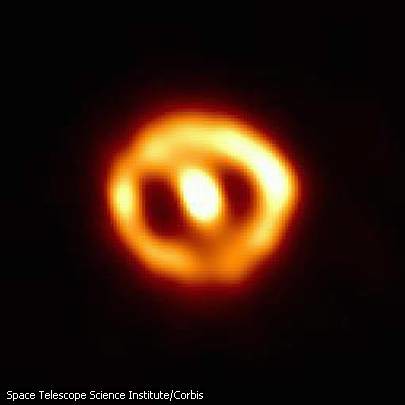
Nova Cygni
A star in the constellation Cygnus (the Swan) suddenly brightened in 1992 in a nova explosion. In a nova, a layer of material on the outer part of the star suddenly explodes. In this photo from 1993, the expanding shell of gas that caused the brightening is visible as a ring around the star.
Space Telescope Science Institute/Corbis
Sometimes stars brighten drastically, becoming as much as 100 times brighter than they were. These stars are called novas (Latin for 'new stars'). They are not really new, just much brighter than they were earlier. A nova is a binary, or double, star in which one member is a white dwarf and the other is a giant or supergiant. Matter from the large star falls onto the small star. After a thick layer of the large star’s atmosphere has collected on the white dwarf, the layer burns off in a nuclear fusion reaction. The fusion produces a huge amount of energy, which, from Earth, appears as the brightening of the nova. The nova gradually returns to its original state, and material from the large star again begins to collect on the white dwarf.
| A6 |
| Supernovas |
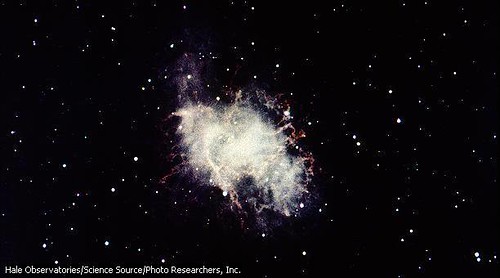
Crab Nebula
An exploding supernova star leaves behind a rapidly expanding cloud of gaseous material called a nebula. The Crab Nebula was produced when a star in the Milky Way Galaxy exploded. Light from the supernova reached Earth in 1054. At the center of the Crab Nebula, a spinning pulsar star emits light of varying brightness. This illuminates the gaseous particles of the nebula, giving a cloudlike appearance.
Hale Observatories/Science Source/Photo Researchers, Inc.
Sometimes stars brighten many times more drastically than novas do. A star that had been too dim to see can become one of the brightest stars in the sky. These stars are called supernovas. Sometimes supernovas that occur in other galaxies are so bright that, from Earth, they appear as bright as their host galaxy.
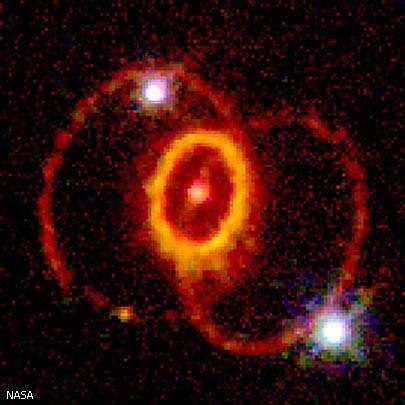
Supernova 1987A
The Hubble Space Telescope took this photo of the aftermath of the 1987A supernova in 1994, seven years after the light from the exploding star first reached Earth. The supernova occurred in the Large Magellanic Cloud, a satellite galaxy of the Milky Way. Scientists do not yet agree on the mechanism that created the rings surrounding the remnants of the star.
NASA
The other type of supernova occurs when a supergiant star uses up all its nuclear fuel in nuclear fusion reactions. The star uses up its hydrogen fuel, but the core is hot enough that it provides the initial energy necessary for the star to begin “burning” helium, then carbon, and then heavier elements through nuclear fusion. The process stops when the core is mostly iron, which is too heavy for the star to “burn” in a way that gives off energy. With no such fuel left, the inward gravitational attraction of the star’s material for itself has no outward balancing force, and the core collapses. As it collapses, the core releases a shock wave that tears apart the star’s atmosphere. The core continues collapsing until it forms either a neutron star or a black hole, depending on its mass.
Only a handful of supernovas are known in our galaxy. The last Milky Way supernova seen from Earth was observed in 1604. In 1987 astronomers observed a supernova in the Large Magellanic Cloud, one of the Milky Way’s satellite galaxies (see Magellanic Clouds). This supernova became bright enough to be visible to the unaided eye and is still under careful study from telescopes on Earth and from the Hubble Space Telescope. A supernova in the process of exploding emits radiation in the X-ray range and ultraviolet and radio radiation studies in this part of the spectrum are especially useful for astronomers studying supernova remnants.
| A7 |
| Neutron Stars and Pulsars |
Neutron stars are the collapsed cores sometimes left behind by supernova explosions. Pulsars are a special type of neutron star. Pulsars and neutron stars form when the remnant of a star left after a supernova explosion collapses until it is about 10 km (about 6 mi) in radius. At that point, the neutrons—electrically neutral atomic particles—of the star resist being pressed together further. When the force produced by the neutrons balances the gravitational force, the core stops collapsing. At that point, the star is so dense that a teaspoonful has the mass of a billion metric tons.
Neutron stars become pulsars when the magnetic field of a neutron star directs a beam of radio waves out into space. The star is so small that it rotates from one to a few hundred times per second. As the star rotates, the beam of radio waves sweeps out a path in space. If Earth is in the path of the beam, radio astronomers see the rotating beam as periodic pulses of radio waves. This pulsing is the reason these stars are called pulsars.
Some neutron stars are in binary systems with an ordinary star neighbor. The gravitational pull of a neutron star pulls material off its neighbor. The rotation of the neutron star heats the material, causing it to emit X rays. The neutron star’s magnetic field directs the X rays into a beam that sweeps into space and may be detected from Earth. Astronomers call these stars X-ray pulsars.
Gamma-ray spacecraft detect bursts of gamma rays about once a day. The bursts come from sources in distant galaxies, so they must be extremely powerful for us to be able to detect them. A leading model used to explain the bursts is the merger of two neutron stars in a distant galaxy with a resulting hot fireball. A few such explosions have been seen and studied with the Hubble and Keck telescopes.
| A8 |
| Black Holes |
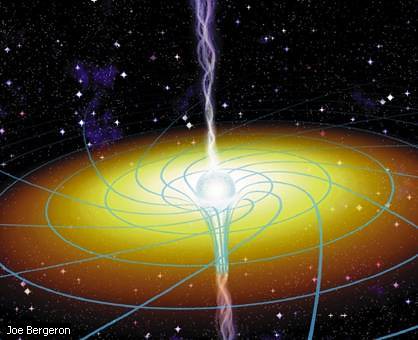
Dragging Space and Time
The results of two studies announced in early November 1997 provide unprecedented support for “frame-dragging,” a concept predicted by physicist Albert Einstein's general theory of relativity. Frame-dragging describes how massive objects actually distort space and time around themselves as they rotate. One of the studies examined frame-dragging around black holes, an example of which is shown here in an artist's conception.
Joe Bergeron
Black holes are objects that are so massive and dense that their immense gravitational pull does not even let light escape. If the core left over after a supernova explosion has a mass of more than about five times that of the Sun, the force holding up the neutrons in the core is not large enough to balance the inward gravitational force. No outward force is large enough to resist the gravitational force. The core of the star continues to collapse. When the core's mass is sufficiently concentrated, the gravitational force of the core is so strong that nothing, not even light, can escape it. The gravitational force is so strong that classical physics no longer applies, and astronomers use Einstein’s general theory of relativity to explain the behavior of light and matter under such strong gravitational forces. According to general relativity, space around the core becomes so warped that nothing can escape, creating a black hole. A star with a mass ten times the mass of the Sun would become a black hole if it were compressed to 90 km (60 mi) or less in diameter.
Astronomers have various ways of detecting black holes. When a black hole is in a binary system, matter from the companion star spirals into the black hole, forming a disk of gas around it. The disk becomes so hot that it gives off X rays that astronomers can detect from Earth. Astronomers use X-ray telescopes in space to find X-ray sources, and then they look for signs that an unseen object of more than about five times the mass of the Sun is causing gravitational tugs on a visible object.
| B |
| Star Locations |
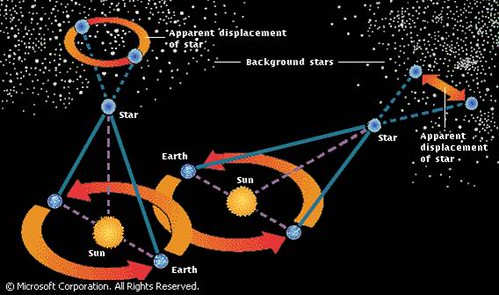
Stellar Parallax
As Earth moves around the Sun, distant stars appear to move in the sky. This apparent displacement, known as stellar parallax, is most evident at six-month intervals, when Earth is at opposite ends of its solar orbit. Astronomers use stellar parallax to determine a star’s distance from Earth by studying the angle formed by the actual star and its two parallactic positions (seen here as dotted blue lines). This illustration depicts two examples of stellar parallax.
© Microsoft Corporation. All Rights Reserved.
The basic method that astronomers use to find the distance of a star from Earth uses parallax. Parallax is the change in apparent position of a distant object when viewed from different places. For example, imagine a tree standing in the center of a field, with a row of buildings at the edge of the field behind the tree. If two observers stand at the two front corners of the field, the tree will appear in front of a different building for each observer. Similarly, a nearby star's position appears slightly different when seen from different angles.
Parallax also allows human eyes to judge distance. Each eye sees an object from a slightly different angle. The brain compares the two pictures to judge the distance to the object. Astronomers use the same idea to calculate the distance to a star. Stars are very far away, so astronomers must look at a star from two locations as far apart as possible to get a measurement. The movement of Earth around the Sun makes this possible. By taking measurements six months apart from the same place on Earth, astronomers take measurements from locations separated by the diameter of Earth’s orbit. That is a separation of about 300 million km (186 million mi). The nearest stars will appear to shift slightly with respect to the background of more distant stars. Even so, the greatest stellar parallax is only about 0.77 seconds of arc, an amount 4,600 times smaller than a single degree. Astronomers calculate a star’s distance by dividing 1 by the parallax. Distances of stars are usually measured in parsecs. A parsec is 3.26 light-years, and a light-year is the distance that light travels in a year, or about 9.5 trillion km (5.9 trillion mi). Proxima Centauri, the Sun’s nearest neighbor, has a parallax of 0.77 seconds of arc. This measurement indicates that Proxima Centauri’s distance from Earth is about 1.3 parsecs, or 4.2 light-years. Because Proxima Centauri is the Sun’s nearest neighbor, it has a larger parallax than any other star.
Astronomers can measure stellar parallaxes for stars up to about 500 light-years away, which is only about 2 percent of the distance to the center of our galaxy. Beyond that distance, the parallax angle is too small to measure.
A European Space Agency spacecraft named Hipparcos (an acronym for High Precision Parallax Collecting Satellite), launched in 1989, gave a set of accurate parallaxes across the sky that was released in 1997. This set of measurements has provided a uniform database of stellar distances for over 100,000 stars and a somewhat less accurate database of over 1 million stars. These parallax measurements provide the base for measurements of the distance scale of the universe. Hipparcos data are leading to more accurate age calculations for the universe and for objects in it, especially globular clusters of stars.
| C |
| Starlight |
Astronomers use a star’s light to determine the star’s temperature, composition, and motion. Astronomers analyze a star’s light by looking at its intensity at different wavelengths. Blue light has the shortest visible wavelengths, at about 400 nanometers. (A nanometer, abbreviated nm, is one billionth of a meter, or about one forty-thousandth of an inch.) Red light has the longest visible wavelengths, at about 650 nm. A law of radiation known as Wien's displacement law (developed by German physicist Wilhelm Wien) links the wavelength at which the most energy is given out by an object and its temperature. A star like the Sun, whose surface temperature is about 6000 K (about 5730°C or about 10,350°F), gives off the most radiation in yellow-green wavelengths, with decreasing amounts in shorter and longer wavelengths. Astronomers put filters of different standard colors on telescopes to allow only light of a particular color from a star to pass. In this way, astronomers determine the brightness of a star at particular wavelengths. From this information, astronomers can use Wien’s law to determine the star’s surface temperature.
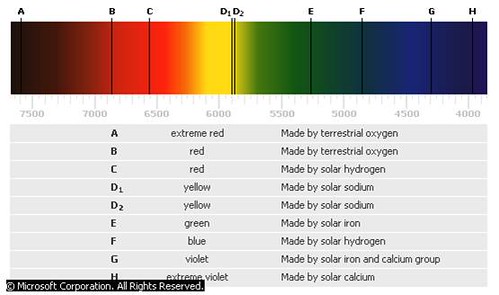
Spectrum of the Sun
Radiation from the Sun is photographed using a spectrometer and is analyzed through the use of a spectrograph. The dark lines in the spectrum are called absorption lines, and are caused by the absorption of radiation by elements in the Sun’s atmosphere. By studying these absorption lines, scientists are able to identify the elements present in the Sun. The prominent line at the red end of the spectrum is one of the hydrogen lines and the lines in the yellow indicate the presence of sodium.
© Microsoft Corporation. All Rights Reserved.
Many stars have thousands of spectral lines from iron and other elements near iron in the periodic table. Other stars of the same temperature have relatively few spectral lines from such elements. Astronomers interpret these findings to mean that two different populations of stars exist. Some formed long ago, before supernovas produced the heavy elements, and others formed more recently and incorporated some heavy elements. The Sun is one of the more recent stars.

Distribution of the Galaxies
This false-color optical map, covering about 4,300 square degrees, or 10 percent of the sky, shows the distribution in space of some 2 million galaxies. Galaxies tend to clump together—in this image, black represents areas of empty space and blue represents the galaxies. The image suggests that galaxies dot the surfaces of giant interconnected bubbles surrounding immense voids of empty space.
Maddox-Sutherland-Efstathiou-Loveday/Photo Researchers, Inc.
Astronomers study galaxies to learn about the structure of the universe. Galaxies are huge collections of billions of stars. Our Sun is part of the Milky Way Galaxy. Galaxies also contain dark strips of dust and may contain huge black holes at their centers. Galaxies exist in different shapes and sizes. Some galaxies are spirals, some are oval, or elliptical, and some are irregular. The Milky Way is a spiral galaxy. Galaxies tend to group together in clusters.
| A |
| The Milky Way |

Milky Way Galaxy
Our own solar system exists within one of the spiral arms of the disk-shaped galaxy called the Milky Way. This false-color image looks toward the center of the Milky Way, located 30,000 light-years away. Bright star clusters are visible along with darker areas of dust and gas.
Morton-Milon/Science Source/Photo Researchers, Inc.
Our Sun is only one of about 400 billion stars in our home galaxy, the Milky Way. On a dark night, far from outdoor lighting, a faint, hazy, whitish band spans the sky. This band is the Milky Way Galaxy as it appears from Earth. The Milky Way looks splotchy, with darker regions interspersed with lighter ones.
The Milky Way Galaxy is a pinwheel-shaped flattened disk about 75,000 light-years in diameter. The Sun is located on a spiral arm about two-thirds of the way out from the center. The galaxy spins, but the center spins faster than the arms. At Earth’s position, the galaxy makes a complete rotation about every 200 million years.
When observers on Earth look toward the brightest part of the Milky Way, which is in the constellation Sagittarius, they look through the galaxy’s disk toward its center. This disk is composed of the stars, gas, and dust between Earth and the galactic center. When observers look in the sky in other directions, they do not see as much of the galaxy’s gas and dust, and so can see objects beyond the galaxy more clearly.
The Milky Way Galaxy has a core surrounded by its spiral arms. A spherical cloud containing about 100 examples of a type of star cluster known as a globular cluster surrounds the galaxy. Still farther out is a galactic corona. Astronomers are not sure what types of particles or objects occupy the corona, but these objects do exert a measurable gravitational force on the rest of the galaxy.
| B |
| Characteristics of Galaxies |
Galaxies contain billions of stars, but the space between stars is not empty. Astronomers believe that almost every galaxy probably has a huge black hole at its center.
| B1 |
| Interstellar Matter |
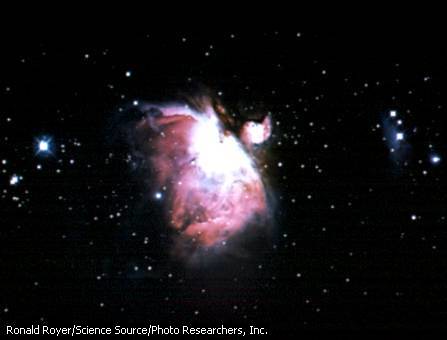
Orion Nebula
Located in the constellation Orion, 1,600 light-years away from Earth, the Orion Nebula (M 42) is a bright cloud of gas and dust where stars are in the process of being born. The Orion Nebula looks bright because it reflects light from the multiple star Theta Orionis, located on one side. Radiation from new stars in the Nebula lights up hydrogen in its outer regions, causing the gas to glow with its characteristic red color. M 42 is spread across more than 15 light-years of space.
Ronald Royer/Science Source/Photo Researchers, Inc.
Astronomers have located over 100 types of molecules in interstellar space. These molecules occur only in trace amounts among the hydrogen. Still, astronomers can use these molecules to map galaxies. By measuring the density of the molecules throughout a galaxy, astronomers can get an idea of the galaxy’s structure.
Interstellar dust sometimes gathers to form dark nebulae, which appear in silhouette against background gas or stars from Earth. The Horsehead Nebula, for example, is the silhouette of interstellar dust against a background HI region. See also Interstellar Matter.
| B2 |
| Galactic Black Holes |
The first known black holes were the collapsed cores of supernova stars, but astronomers have since discovered signs of much larger black holes at the centers of galaxies. These galactic black holes contain millions of times as much mass as the Sun. Astronomers believe that huge black holes such as these provide the energy of mysterious objects called quasars. Quasars are very distant objects that are moving away from Earth at high speed. The first ones discovered were very powerful radio sources, but scientists have since discovered quasars that don’t strongly emit radio waves. Astronomers believe that almost every galaxy, whether spiral or elliptical, has a huge black hole at its center.
Astronomers look for galactic black holes by studying the movement of galaxies. By studying the spectrum of a galaxy, astronomers can tell if gas near the center of the galaxy is rotating rapidly. By measuring the speed of rotation and the distance from various points in the galaxy to the center of the galaxy, astronomers can determine the amount of mass in the center of the galaxy. Measurements of many galaxies show that gas near the center is moving so quickly that only a black hole could be dense enough to concentrate so much mass in such a small space. Astronomers suspect that a significant black hole occupies even the center of the Milky Way. The clear images from the Hubble Space Telescope have allowed measurements of motions closer to the centers of galaxies than previously possible, and have led to the confirmation in several cases that giant black holes are present.
| C |
| Types of Galaxies |
Galaxies are classified by shape. The three types are spiral, elliptical, and irregular. Spiral galaxies consist of a central mass with one, two, or three arms that spiral around the center. An elliptical galaxy is oval, with a bright center that gradually, evenly dims to the edges. Irregular galaxies are not symmetrical and do not look like spiral or elliptical galaxies. Irregular galaxies vary widely in appearance. A galaxy that has a regular spiral or elliptical shape but has some special oddity is known as a peculiar galaxy. For example, some peculiar galaxies are stretched and distorted from the gravitational pull of a nearby galaxy.
| C1 |
| Spiral |
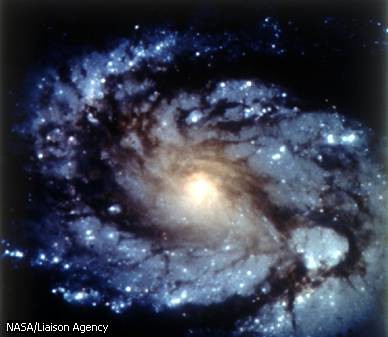
Hubble Photo of Galaxy M100
The Hubble Space Telescope captured this image of the core of galaxy M100. M100 is a spiral galaxy about 1,500 light-years from Earth.
NASA/Liaison Agency
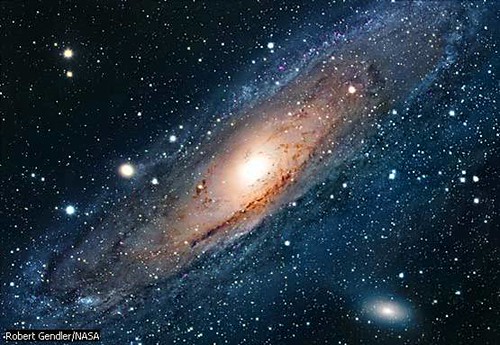
Andromeda Galaxy
The Andromeda Galaxy, a spiral galaxy similar to our own Milky Way Galaxy, is the farthest object from Earth visible to the naked eye. Its whirlpool of stars can be seen from the Northern Hemisphere in the constellation Andromeda. The Milky Way and Andromeda galaxies are part of a group of galaxies called the Local Group, which in turn is part of larger group called the Virgo Cluster.
Robert Gendler/NASA
Some galaxies have a straight, bright, bar-shaped feature across their center, with the spiral arms coming off the bar or off a ring around the bar. With a capital B for the bar, the Hubble types of these galaxies are SBa, SBb, and SBc.
| C2 |
| Elliptical |
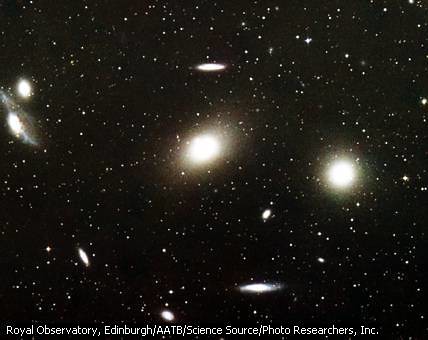 .jpg?v=0">
.jpg?v=0">
Galaxies M86 and M84
The elliptical galaxies M86 (center) and M84 (right) are members of the Virgo cluster of galaxies, located about 50 million light-years away from our smaller cluster, the Local Group. Elliptical galaxies are populated by older stars and contain little interstellar matter. They are usually the brightest galaxies.
Royal Observatory, Edinburgh/AATB/Science Source/Photo Researchers, Inc.
Many clusters of galaxies have giant elliptical galaxies at their centers. Smaller elliptical galaxies, called dwarf elliptical galaxies, are much more common than giant ones. Most of the two dozen galaxies in the Milky Way’s Local Group of galaxies are dwarf elliptical galaxies.
Astronomers classify elliptical galaxies by how oval they look, ranging from E0 for very round to E3 for intermediately oval to E7 for extremely elongated. The galaxy class E7 is also called S0, which is also known as a lenticular galaxy, a shape with an elongated disk but no spiral arms. Because astronomers can see other galaxies only from the perspective of Earth, the shape astronomers see is not necessarily the exact shape of a galaxy. For instance, they may be viewing it from an end, and not from above or below.
| C3 |
| Irregular |
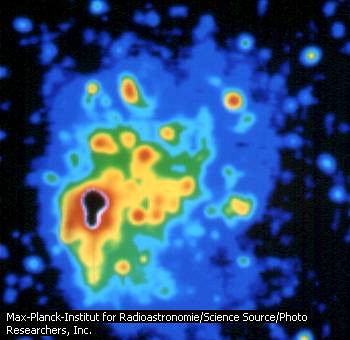
Irregular Galaxy
The Parkes 64-m (210-ft) radio telescope in Australia produced this radio map of the Large Magellanic Cloud. The colors of the image correspond to radio wave intensity; black is the least intense, red the most. A radio map often reveals structures that are invisible to visible-light telescopes.
Max-Planck-Institut for Radioastronomie/Science Source/Photo Researchers, Inc.
Some galaxies have no structure, while others have some trace of structure but do not fit the spiral or elliptical classes. All of these galaxies are called irregular galaxies. The two small galaxies that are satellites to the Milky Way Galaxy are both irregular. They are known as the Magellanic Clouds. The Large Magellanic Cloud shows signs of having a bar in its center. The Small Magellanic Cloud is more formless. Studies of stars in the Large and Small Magellanic Clouds have been fundamental for astronomers’ understanding of the universe. Each of these galaxies provides groups of stars that are all at the same distance from Earth, allowing astronomers to compare the absolute brightness of these stars.
| D |
| Movement of Galaxies |

Demonstration of Hubble’s Law
Hubble’s Law states that galaxies farther away from Earth are receding from Earth more quickly than nearer galaxies. The dots on this balloon represent galaxies. As the balloon is inflated (representing the universe’s expansion), each dot moves away from all the others. To a person viewing the universe from a galaxy, all other galaxies seem to be receding. The distant galaxies appear to be moving away faster than the near ones, which demonstrates Hubble’s law.
© Microsoft Corporation. All Rights Reserved.
In the late 1920s American astronomer Edwin Hubble discovered that all but the nearest galaxies to us are receding, or moving away from us. Further, he found that the farther away from Earth a galaxy is, the faster it is receding. He made his discovery by taking spectra of galaxies and measuring the amount by which the wavelengths of spectral lines were shifted. He measured distance in a separate way, usually from studies of Cepheid variable stars. Hubble discovered that essentially all the spectra of all the galaxies were shifted toward the red, or had redshifts. The redshifts of galaxies increased with increasing distance from Earth. After Hubble’s work, other astronomers made the connection between redshift and velocity, showing that the farther a galaxy is from Earth, the faster it moves away from Earth. This idea is called Hubble’s law and is the basis for the belief that the universe is fairly uniformly expanding. Other uniformly expanding three-dimensional objects, such as a rising cake with raisins in the batter, also demonstrate the consequence that the more distant objects (such as the other raisins with respect to any given raisin) appear to recede more rapidly than nearer ones. This consequence is the result of the increased amount of material expanding between these more distant objects.
Hubble's law states that there is a straight-line, or linear, relationship between the speed at which an object is moving away from Earth and the distance between the object and Earth. The speed at which an object is moving away from Earth is called the object’s velocity of recession. Hubble’s law indicates that as velocity of recession increases, distance increases by the same proportion. Using this law, astronomers can calculate the distance to the most distant galaxies, given only measurements of their velocities calculated by observing how much their light is shifted. Astronomers can accurately measure the redshifts of objects so distant that the distance between Earth and the objects cannot be measured by other means.
The constant of proportionality that relates velocity to distance in Hubble's law is called Hubble's constant, or H. Hubble's law is often written v=Hd, or velocity equals Hubble's constant multiplied by distance. Thus determining Hubble's constant will give the speed of the universe's expansion. The inverse of Hubble’s constant, or 1/H, theoretically provides an estimate of the age of the universe. Astronomers now believe that Hubble’s constant has changed over the lifetime of the universe, however, so estimates of expansion and age must be adjusted accordingly.
The value of Hubble’s constant probably falls between 64 and 78 kilometers per second per megaparsec (between 40 and 48 miles per second per megaparsec). A megaparsec is 1 million parsecs and a parsec is 3.26 light-years. Astronomers used the Hubble Space Telescope to study Cepheid variables in distant galaxies to get an accurate measurement of the distance between the stars and Earth to refine the value of Hubble’s constant. The value these astronomers found was 72 kilometers per second per megaparsec (45 miles per second per megaparsec), with an uncertainty of only 10 percent.
The actual age of the universe depends not only on Hubble's constant but also on how much the gravitational pull of the mass in the universe slows the universe’s expansion. Some data from studies that use the brightness of distant supernovas to assess distance indicate that the universe's expansion is speeding up instead of slowing down. Astronomers invented the term “dark energy” for the unknown cause of this accelerating expansion and are actively investigating these topics.
| VIII |
| THE UNIVERSE |
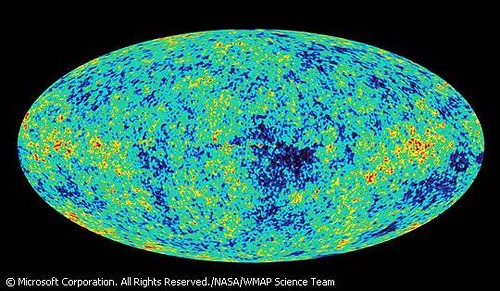
The Sound of the Big Bang
Even when all Earthly and astronomical sources of radio waves are screened out, some static remains on the most sensitive radios. This static is caused by radiation left over from the big bang, the explosion that created the universe.
© Microsoft Corporation. All Rights Reserved./NASA/WMAP Science Team
The ultimate goal of astronomers is to understand the structure, behavior, and evolution of all of the matter and energy that exists. Astronomers call the set of all matter and energy the universe. The universe is infinite in space, but astronomers believe it does have a finite age. Astronomers accept the theory that about 14 billion years ago the universe began as an explosive event resulting in a hot, dense, expanding sea of matter and energy. This event is known as the big bang (see Big Bang Theory). Astronomers cannot observe that far back in time. Many astronomers believe, however, that within the first fraction of a second after the big bang, the universe went through a tremendous inflation, expanding many times in size, before it resumed a slower expansion (see Inflationary Theory).
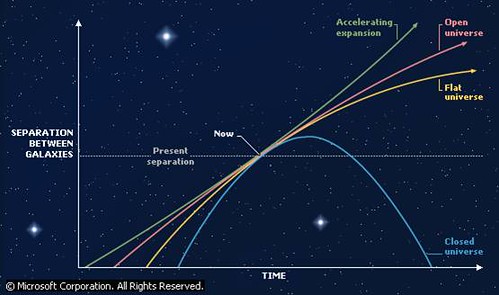
Models of the Universe
According to the widely accepted theory of the big bang, the universe originated about 14 billion years ago and has been expanding ever since. Astronomers recognize four models of possible futures for the universe. According to the closed model, many billions of years from now expansion will slow, stop, and the universe will contract back in upon itself. In the flat model, the universe will not collapse upon itself, but expansion will slow and the universe will approach a stable size. According to the open model, the universe will continue expanding forever. In the accelerating expansion model, the universe will expand faster and faster until even the particles in normal matter are torn away from each other. Astronomers currently favor the accelerating expansion model.
© Microsoft Corporation. All Rights Reserved.
When the universe was about 1 million years old, it had cooled to about 3000 K (about 3300°C or about 5900°F). At that temperature, the protons and heavier nuclei formed during nucleosynthesis could combine with electrons to form atoms. Before electrons combined with nuclei, the travel of radiation through space was very difficult. Radiation in the form of photons (packets of light energy) could not travel very far without colliding with electrons. Once protons and electrons combined to form hydrogen, photons became able to travel through space. The radiation carried by the photons had the characteristic spectrum of a hot gas. Since the time this radiation was first released, it has cooled and is now 3 K (-270°C or –450°F). It is called the primeval background radiation and has been definitively detected and studied, first by radio telescopes and then by the Cosmic Background Explorer (COBE) and Wilkinson Microwave Anisotropy Probe (WMAP) spacecrafts. COBE, WMAP, and ground-based radio telescopes detected tiny deviations from uniformity in the primeval background radiation; these deviations may be the seeds from which clusters of galaxies grew.
The gravitational force from invisible matter, known as dark matter, may have helped speed the formation of structure in the universe. Observations from the Hubble Space Telescope have revealed galaxies older than astronomers expected, reducing the interval between the big bang and the formation of galaxies or clusters of galaxies.
From about 2 billion years after the big bang for another 2 billion years, quasars formed as active giant black holes in the cores of galaxies. These quasars gave off radiation as they consumed matter from nearby galaxies. Few quasars appear close to Earth, so quasars must be a feature of the earlier universe.
A population of stars formed out of the interstellar gas and dust that contracted to form galaxies. This first population, known as Population II, was made up almost entirely of hydrogen and helium. The stars that formed evolved and gave out heavier elements that were made through fusion in the stars’ cores or that were formed as the stars exploded as supernovas. The later generation of stars, to which the Sun belongs, is known as Population I and contains heavy elements formed by the earlier population. The Sun formed about 5 billion years ago and is almost halfway through its 11-billion-year lifetime.
About 4.6 billion years ago, our solar system formed. The oldest fossils of a living organism date from about 3.5 billion years ago and represent cyanobacteria. Life evolved, and 65 million years ago, the dinosaurs and many other species were extinguished, probably from a catastrophic meteor impact. Modern humans evolved no earlier than a few hundred thousand years ago, a blink of an eye on the cosmic timescale.
Contributed By:
Jay M. Pasachoff
Microsoft ® Encarta ® 2007. © 1993-2006 Microsoft Corporation. All rights reserved.

David Nunuk is retarded
ReplyDelete